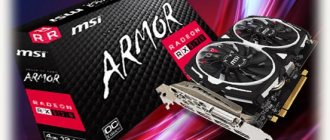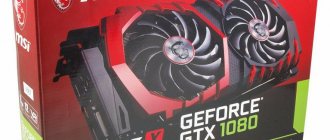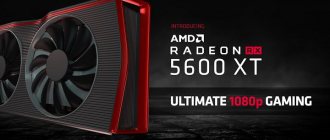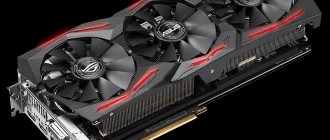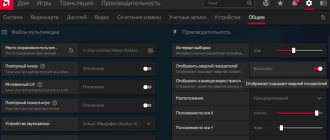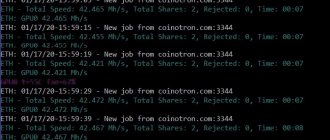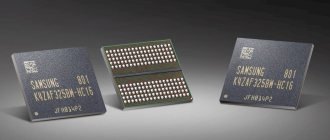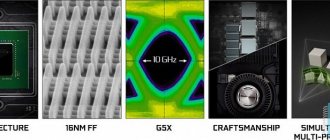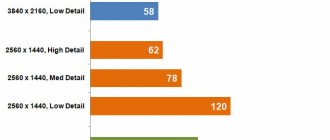RX 470 is a new word in the gaming industry. This powerful graphics card is designed specifically for gamers, so it takes into account all their needs. This video card supports all modern technologies for a comfortable and spectacular game, for example, Vulkan and API DirectX 12, which opens up new possibilities. Powerful asynchronous shaders, the latest geometry calculation methods and the best Graphics Core Next architecture at the moment allow you to achieve incredible image quality. AMD FreeSync technology allows you to truly immerse yourself in the game with smooth, clear images during gameplay, and without any delays, even at the highest frame rates.
Have you thought about becoming a streamer? Or open your own channel on YouTube? Incredible hardware optimization allows you to not only record games in H.265 at 4K resolution and 60 frames per second, but also stream them in real time without interruption.
Specifications
| GCN ARCHITECTURE | 4th generation |
| COMPUTING UNITS | 32 computing units |
| STREAMING PROCESSORS | 2048 |
| CLOCK RATES (BOOST/BASE) | 1206 MHz / 926 MHz |
| PEAK PERFORMANCE | Up to 4.9 teraflops |
| MEMORY CLOCK FREQUENCY (MHz) | 1650 |
| MEMORY BANDWIDTH | 211 GB/s |
| MEMORY INTERFACE | 256 bit |
| MEMORY TYPE | GDDR5 |
| TYPICAL POWER CONSUMPTION OF THE BOARD | 120 W |
| AMD FREESYNC™ TECHNOLOGY | Yes |
| DIRECTX® 12 SUPPORT | Yes |
| VULKAN™ SUPPORT | Yes |
| VIRTUAL ULTRA-HIGH RESOLUTION | Yes |
| HDMI VERSION | 2.0 |
| DISPLAYPORT VERSION | 1.4 HDR compatible |
| AMD EYEFINITY TECHNOLOGY (MAXIMUM NUMBER OF MONITORS) | Up to 6 monitors with DisplayPort MST hub |
Mining on rx 470, characteristics
Graphics accelerator characteristics:
- Processor – Polaris 10 Pro;
- Microchip manufacturing technology - 14 Hm;
- Architecture - GCN 1.3;
- Graphics core area - 232 mm?;
- Number of transistors — 2048;
- DirectX support - DirectX 12;
- Video memory - 4 GB/8 GB;
- Effective memory frequency - 1650 MHz (4GB), 2000 MHz (8GB);
- The clock frequency of the video processor is 920/1206 MHz;
- Connections : DisplayPort, HDMI, DVI-D;
- Additional power supply - 8-pin.
Additional power to the video card ensures stable operation during overclocking. The Polaris structure is very practical for mining, which is why the rx470 remains in demand despite the release of newer series.
For example, if you compare the rx 470 and rx 480 in mining, the first one is ahead in terms of energy efficiency. Not to mention the video cards that were produced earlier (r9 380, r9 390, etc.)
In addition, graphic adapters of this line can be converted into Rx 570 with simple manipulations. You need cards from the same manufacturer and with the same memory. Link to video instructions:
. After reflashing, production efficiency improves. Please note that in case of an error, the Rx 470 will not turn into a 570, but into a brick. You perform all actions at your own peril and risk.
| Model | Hashrate (MH/s) | Consumption (Wh) | Efficiency on the Ethash algorithm (MHS/W) |
| Rx 470 | 27 | 120 | 0,220 |
| Rx 480 | 29.5 | 135 | 0,218 |
| Rx 570 | 28 | 130 | 0,215 |
| Rx 580 | 30.1 | 140 | 0,215 |
| Rx 590 | 33 | 150 | 0,22 |
Video card performance in mining
The productivity of the rx 470 mining farm is directly related to the hash algorithm. The mining calculator helps you choose the most profitable coins. The optimal coin option for the Ethereum blockchain network (Ethash).
| Algorithm | Hashrate | Consumption |
| Ethash | 27 Mh/s | 120 W |
| Zhash | 18 H/s | 110 W |
| CNSaber | 590 H/s | 100 W |
| CNHeavy | 590 H/s | 100 W |
| CNHaven | 590 H/s | 100 W |
| CryptoNightV8 | 660 H/s | 120 W |
| Aion | 80 H/s | 110 W |
| NeoScrypt | 680 Kh/s | 140 W |
| BCD | 6.8 Mh/s | 120 W |
| TimeTravel10 | 7.5 Mh/s | 120 W |
| X16R | 4.5 Mh/s | 90 W |
| Lyra2Z | 0.4 Mh/s | 105 W |
| Hex | 2.0 Mh/s | 85 W |
| ProgPow | 6.4 Mh/s | 130 W |
| X22i | 3.2 Mh/s | 120 W |
The cryptocurrency market is volatile, so the owner of a mining farm must constantly keep his finger on the pulse of events. New promising projects appear periodically. Mining on the Dagger Hashimoto (Ethash) algorithm in dual with (DCR, MAX, SMART, XVG) worked well, but in 2020 , this topic is no longer relevant.
Manufacturers
Many companies began mass production of this video card, the most famous of them: Gigabyte, MSI, XFX, Asus, PowerColor. They are all somewhat different and have their own distinctive features.
ASUS
The version from Asus will delight the user with factory overclocking of the processor; it can work in two modes: “OS” and “Gaming”. The first with a frequency of up to 1270 MHz, the second up to 1250 MHz. The memory frequency is 1650 MHz, while the effective frequency is 6600 MHz. The manufacturer claims that this model runs 25% faster than its predecessor, the Radeon R9 380. The video card is assembled on an Asus proprietary printed circuit board. There is a power subsystem consisting of six phases. Five for graphics GPU, one for memory needs. There is also a six-pin connector so that additional power can be provided to the device. The card is cooled using the “DirectCU II” system, consisting of an aluminum radiator and a pair of fans that turn off when the device temperature is low, as well as several heat sink pipes.
PowerColor
The video card has similar characteristics, however, GDDR5 video memory in combination with a seven-phase power system and an eight-pin connector should, in theory, have slightly better overclocking potential. The card's memory has a frequency response of 1750 MHz, while the effective one is 7000 MHz. The cooling system is also quite good, especially considering the massive radiator, as well as the specially shaped blades used in the fan.
MSI
MSI presents 4 types of cards. They are divided into two lines: Gaming and Gaming X. Both lines have cards with 4 and 8 GB, respectively. The Gaming line GPU operates at frequencies not exceeding 1230 MHz, and the memory is about 6600 MHz. Gaming X is represented by a GPU overclock of 1254 MHz, as well as a memory of 6700 MHz. All cards have a 6-phase power subsystem, as well as an eight-pin connector for it. The card is cooled using Twin Frozr VI technology.
Gigabyte
At the moment, only the model with 4 GB memory has been shown. The GPU is brought to 1230 MHz, memory at 6600 MHz. Structure of the power subsystem: 6+1 - phases, eight-pin connector. The card is cooled using WindForce 2X. In addition, there is an intensifying plate and backlight.
XFX
“XFX” demonstrates 4 variations of “RX 470” at once. Moreover, they all have only 4 GB of memory. 4+1 phase and six-pin connector are the distinctive features of the power system. Models often differ only in quantity, but one model has a special cooling system built into it.
The most powerful model, the Radeon RX 470 RS Black Limited Edition, has a 1280 MHz processor and 7000 MHz memory.
MSI RADEON RX470 GAMING X 8G video card review
The new series of video cards with AMD Polaris GPUs promises to be interesting. The Radeon RX460 and RX470 models did not have reference board models, so each manufacturer is trying their best to assemble the best and fastest video card. In the case of the Radeon RX460, there is factory overclocking, a different number and location of power phases, as well as memory expansion up to 8 GB and, of course, lighting of the cooling system.
The MSI RADEON RX470 GAMING X 8G graphics card combines all the features listed above. At the same time, the video card is not that expensive among gaming solutions. About 18,300 rubles at the time of writing this article.
MSI RADEON RX470 GAMING X 8G
The video card comes in a classic red box, decorated in the MSI corporate style. The front side shows the video card itself and its main characteristics. In particular, the MSI RADEON RX470 GAMING X 8G received a non-reference board design, 8 GB of RAM and a proprietary MSI TWIN FROZR VI cooling system.
On the back of the package, as expected, the main characteristics and features of the video card are indicated.
Externally, the MSI RADEON RX470 GAMING X 8G is very similar to another video card from MSI - GTX 1060 GAMING X 6G. This similarity is achieved thanks to the same cooling systems, which cover almost the entire textolite board and its electronic filling.
On the plastic casing of the CO, next to the second fan, there are 12 “fins”. They contain red backlight LEDs. The dimensions of the video card are 276x140x37 mm. Simply put, it will fit in most system units and occupy two slots in them.
The set of connectors on the MSI RADEON RX470 GAMING X 8G is typical for modern gaming video cards. These are two DisplayPort v1.4, and two HDMI v2.0b. The only DVI-D (Dual Link) connector does not have contacts for a D-SUB adapter. Alas, this approach has now become the norm for manufacturers of modern video cards and motherboards with video outputs.
There's nothing interesting on the top and bottom sidebars. Everything here is arranged exactly the same as with most video cards.
To power the video card, one 8-pin connector is used, which is located in its usual place.
The reverse side of the textolite board is not covered with a metal panel, so there is nothing interesting on it either.
Cooling system and internal structure
As we already mentioned, the video card received an MSI Twin Frozr VI cooling system. This is the sixth version of the famous cooling system from MSI, which was introduced back in 2009.
Two TORX 2.0 fans with dispersion blades are responsible for cooling the radiator. According to the manufacturer's website, this blade design increases air flow by 22%. In addition, the fans will not spin until the processor temperature reaches 60 degrees.
The radiator on the video card turned out to be massive - we saw approximately the same radiator on the GTX 1060 from MSI. To remove heat from the GPU, two copper heat pipes with a maximum diameter of 8 mm are also used. At the same time, the tubes themselves do not directly contact the video core - for this, the radiator has a nickel-plated copper base.
To cool the power subsystem of the MSI RADEON RX470 GAMING X 8G, a separate passive radiator is provided, which is held in place by two screws. On its reverse side there is a thermal tape, which creates reliable contact between the hot electronics and the radiator.
Now let's look at the MSI RADEON RX470 GAMING X 8G board without radiators. Since the RADEON RX470 does not have a reference design, each video card manufacturer is forced to create their own variants.
MSI engineers equipped the video card with a 4-phase power supply system for the GPU and a 2-phase power supply system for the memory. At the same time, on the textolite board you can see two more areas for the GPU power phases. They will probably be used in the Radeon RX 480 from MSI.
The video card has three connectors for connecting fans and lighting. Two of them are in the lower right corner of the textolite board, and the last, third one is in the upper right.
The heart of the video card is the Polaris 10 video core, and the memory is comprised of eight Micron 5XA47 D9SSX chips. By the way, next to the GPU substrate there are four spacers that will prevent the radiator from crushing the Polaris 11 crystal if installed incorrectly or too tightly.
Specifications
| GPU codename | Polaris 10 |
| Technical process | 14 nm |
| Number of transistors, billion | 5 700 |
| Quantity Number of shader ALUs | 2048 |
| Number of texture blocks | 128 |
| Number of ROP blocks | 32 |
| GPU frequency | Up to 1254 MHz in OC mode; Up to 1242 MHz in game mode Up to 1206 MHz in quiet mode; |
| Video memory size | 8 GB GDDR5 |
| Video memory frequency | 6700 MHz in OC mode; 6600 MHz in gaming and quiet modes |
| Video memory size | 256 bit |
| Interface | PCIe 3.0 x16 |
| Connectors | 1x DVI-DL, 2x HDMI 2.0b, 2x DisplayPort 1.4 |
| Energy consumption | 110 W |
| Dimensions | 276x140x37 mm |
| Approximate price | 18,300 rubles |
Like other MSI Radeon RX graphics cards, the RX470 GAMING X 8G version can operate in several modes: quiet, gaming and overclocking. The difference between them lies in the maximum frequencies of the GPU and video memory. The highest GPU and memory frequencies can be achieved by turning on the “overclocker” mode (1254 and 6,700 MHz) and the lowest - in quiet mode (1206 and 6,600 MHz).
The video card has also undergone a slight factory overclock. The nominal maximum video core frequency for the Radeon RX 470 is 1206 MHz for the video core and 6600 MHz for video memory, which corresponds to the “quiet” mode of the video card. Our version of the RX470 had higher frequencies. In the fastest, “overclocking” mode, the video core frequency increases to 1254 MHz, and the video memory to 6,700 MHz
Test bench
Processor: Intel Core i5-6600K Motherboard: ASUS Z170-Pro Cooler: DeepCool Lucifer V2 RAM: GEIL DDR4 DRAGON RAM Video card: MSI RADEON RX470 GAMING X 8G Power supply: Be quiet! Dark Power Pro 11 850W Windows 10 64 Bit
Temperature and noise level
The MSI TWIN FROZR VI cooling system did its job perfectly. As stated by the manufacturer, the fans did not spin until the GPU temperature reached 60 degrees. Then, after turning on the fans, the cooling system worked quietly and made almost no sign of its presence. As for the maximum temperature of the video core, it was 73 degrees. Good results.
Test results
The MSI RADEON RX470 GAMING X 8G video card showed good results in testing. The large amount of video memory of 8 GB allowed it to gain several additional FPS in each of the benchmarks.
Conclusion
The MSI RADEON RX470 GAMING X 8G, like all video cards with AMD chips, showed results that corresponded to its cost. A large amount of video memory of 8 GB will help the video card squeeze out several additional FPS in modern games at resolutions of 1920x1080 and 2560x1440 pixels. Also, thanks to the large amount of memory, it will be possible to run games in 4K resolution - in this case, the MSI RADEON RX470 GAMING X 8G will cope with the task much better than its counterparts, which have only 4 GB of RAM on board. But don’t expect miracles from an inexpensive gaming video card: in order to play in 4K at maximum graphics settings, you will need a flagship video adapter. One way or another, double the amount of video memory gives an advantage in heavy testing, and this is great.
As for the price of the MSI RADEON RX470 GAMING X 8G, it does not bite at all when compared with the price tags of other gaming video cards. At the time of writing this article, the average price of the MSI RADEON RX470 GAMING X 8G is 18,300 rubles.
Review of the MSI RADEON RX470 GAMING X 8G video card was last modified: December 21, 2016 by Konstantin
AMDMSIMSI RADEON RX470 GAMING X 8GradeonRadeon RX 470
RX 470 performance and tests
First, let's compare the 4 and 8 GB versions of the video card with each other, and then consider their performance in comparison with other analogues.
When making such a comparison, it is important to take into account that regardless of the amount of memory, its frequency in both variations will be identical, namely 6600 MHz. The 256-bit data bus is also the same.
And so, let's go through the games on which testing took place. All games were set to maximum graphics with all additional textures in both 1080p and 4K resolution.
Total War: Warhammer
At 1080p, the 8GB model produces 69 frames, while its smaller 4GB sibling produces 65 frames.
At 4K everything is much worse. 8GB has 24 frames while 4GB has 22 frames. However, it is understandable. If you want to play in such high resolution, take two RX 470.
DOOM (2016)
At 1080p, the 8GB model produces 87 frames, while the 4GB model produces 84 frames.
At 4K the result is 29 and 27 frames, respectively.
GTA V
At 1080p, the 8 GB model produces 81 fps, and the 4 GB model produces 76 fps.
At 4K the result is 29 and 25 frames, respectively.
The Witcher 3: Wild Hunt
At 1080p, the 8 GB version has 52 frames, and the 4 GB version has 49.
At 4K, 8GB has 24 frames, while 4GB only has 22.
Bottom line
As we can see, the difference between the 4 and 8 GB versions is not so significant and averages 3-5 fps.
Which model to choose, the main nuances when buying a used one
Several companies are involved in the production of 470 line graphics accelerators. Which one should you choose for cryptocurrency computing?
The best rx 470 for mining should be high-speed and reliable in operation. It is possible to equip the rig with video cards of the same series from different manufacturers.
Brief overview of models:
The low noise MSI rx 470 mining version was first released in Japan in 2022. Standard MSI GPUs are also well adapted for mining, thanks to dual-chamber air-cooling radiators. The video card is available in two versions with 4 GB and 8 GB of video memory.
Model Specifications:
- Consumption – 130 W;
- Memory – 4 GB, 7000 MHz;
- Additional power – 8 pin;
- PSU power – 500 W.
On the Powercolor rx 470 , mining is convenient, thanks to dual BIOS/UEFI and an overclocking mode switch. A special profile of the cooler blades and a nickel radiator grille with heat-dissipating pipes guarantee protection against overheating under high loads.
Model Specifications:
- Consumption – 120 W;
- Memory – 4 GB, 6600 MHz;
- Additional power – 8 pin;
- PSU power – 450 W.
On the gaming Gigabyte rx 470, mining is no worse than complex computer games. XTREME Engine utility makes it easy to overclock the device to the desired parameters. WINDFORCE 2X coolers will provide effective heat dissipation, and color LED backlighting allows you to visually monitor the operation of the video card.
Model Specifications:
- Consumption – 120 W;
- Additional power – 8 pin;
- Memory 4GB, 7000 MHz;
- PSU power – 450 W.
For Asus rx 470, mining is a native element. A video card with a Samsung memory chip, produced specifically for cryptocurrency mining. The video card quickly fails due to a poor cooling system; after 1 year of use, the killers stop spinning. We do not recommend buying such video cards for mining 24/7
Model Specifications:
- Consumption – 120 W;
- Memory – 4GB, 7000 MHz;
- Additional power – 8 pin;
- PSU power – 450 W.
On the Sapphire rx 470 , mining will be as productive as possible. The graphics processor is not inferior in power to the 480 model. Even with standard parameters, the sapphire rx 470 demonstrates a high hashrate in mining.
Model Specifications:
- Consumption – 175 W;
- Memory – 8 GB , 8000 MHz;
- Additional power – 8 pin;
- PSU power – 500 W.
The power supply for the rx 470 mining farm is selected by power based on the amount of consumption of the nodes (GPU, riser, motherboard, processor) with the addition of 20% to protect against overload.
Before purchasing a used video card, you should carefully inspect the product. First of all, pay attention to such criteria.
- Date of sale.
- Factory seals and stickers.
- The presence of swollen and chipped parts.
- PCB color. After repairs, the silk-screen printing darkens and the shade of the textolite changes.
- Degree of cooler wear. The blades should turn easily by hand, without any extraneous sounds or play.
After an external examination, performance tests are carried out using special programs ( GPU-Z , FurMark etc.).
Factory defects appear in the first months. If the rx470 worked in mining for a year without breakdowns, then, subject to careful operation, it will serve the new owner for a long time. But no one is immune from troubles, so it is better for a mining farm to purchase new GPUs.
Comparison of Radeon RX 470 with analogues
Let's look at the capabilities of the RX 470 in comparison with its closest competitors using specific examples.
Batman: Arkham Knight
| Video card | FPS |
| Radeon RX 480 8GB | 45,8 – 71,5 |
| Radeon R9 290 4GB | 44,2 — 65 |
| Radeon RX 470 4GB | 41 – 66,2 |
| GeForce GTX 1060 6GB | 47 – 73 |
| GeForce GTX 970 4GB | 43 — 69 |
Battlefield 4
| Video card | FPS |
| Radeon RX 480 8GB | 34 – 48,4 |
| Radeon R9 290 4GB | 41,2 – 52,2 |
| Radeon RX 470 4GB | 31,8 – 43,9 |
| GeForce GTX 1060 6GB | 54,2 – 69,4 |
| GeForce GTX 970 4GB | 45 – 58,4 |
However, after overclocking, the RX 470 increases its performance by 15% and reaches the level of the RX 480.
Fallout 4
| Video card | FPS |
| Radeon RX 480 8GB | 38,8 – 49,4 |
| Radeon R9 290 4GB | 39,4 – 49, 7 |
| Radeon RX 470 4GB | 37 — 45 |
| GeForce GTX 1060 6GB | 43 – 56,1 |
| GeForce GTX 970 4GB | 41,4 – 51,9 |
After overclocking, the RX 470 also reaches the level of the RX 480.
Tom Clancy's The Division
| Video card | FPS |
| Radeon RX 480 8GB | 35,6 – 58,6 |
| Radeon R9 290 4GB | 31 – 50,7 |
| Radeon RX 470 4GB | 33 – 53,5 |
| GeForce GTX 1060 6GB | 36,4 – 62,1 |
| GeForce GTX 970 4GB | 33 – 56,3 |
When overclocking the RX 470, it even beats the 480 by 3-4%.
Video card characteristics
The graphics processor installed in the Radeon RX 470 is the same Polaris 10 family, but with missing (or trimmed) Compute Units. So, if the Radeon RX 480 had 36 Compute Units units, then the characteristics of the RX 470 include only 32 such units, which is why the number of stream processors (shader ALUs) is reduced to 2,048. The GPU operates on a 256-bit memory bus width, which corresponds to standard performance. The video card is equipped with 4 GB of video memory, which does not allow it to be elevated to the podium, but active systems that allow you to overclock the characteristics to the level of its older brother inspire hopes for a smooth gameplay without brakes and clumsy drawing of graphic elements (with the exception of real errors on the part of the game code). The video card supports DirectX 12 technology.
The base core clock frequency is 926 MHz, which can be overclocked to 1.206 MHz, while the core temperature remains static at 70-75 degrees. This is achieved thanks to a modern cooling system with two coolers and a biaxial radiator.
Memory bandwidth is up to 211 gigabytes per second, which is the optimal value. RAM frequency installed in GDDR5 memory type: 6.6 GHz. Radeon RX 470 contains 128 NMU texture units.
Applicability and conclusion
Among video cards costing up to $300, the RX 470 performs well and is one of the leading models, especially considering that it is often significantly cheaper than its analogues with the same power. This especially applies to rivals from Nvidia. A distinctive feature of the card is its overclocking potential, which even an ordinary user can reveal.
Who and for what purposes is this video card suitable? Of course, it is primarily aimed at gamers, but its high technical performance allows it to be successfully used in the field of 3D modeling and video rendering.
